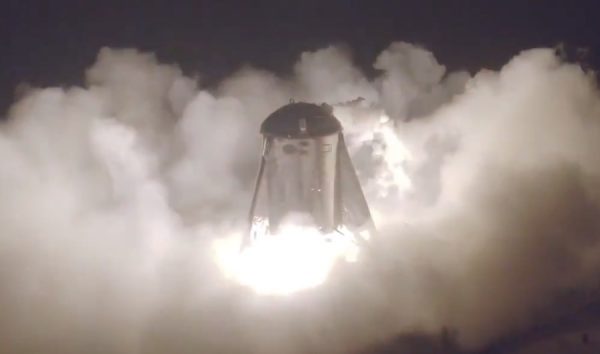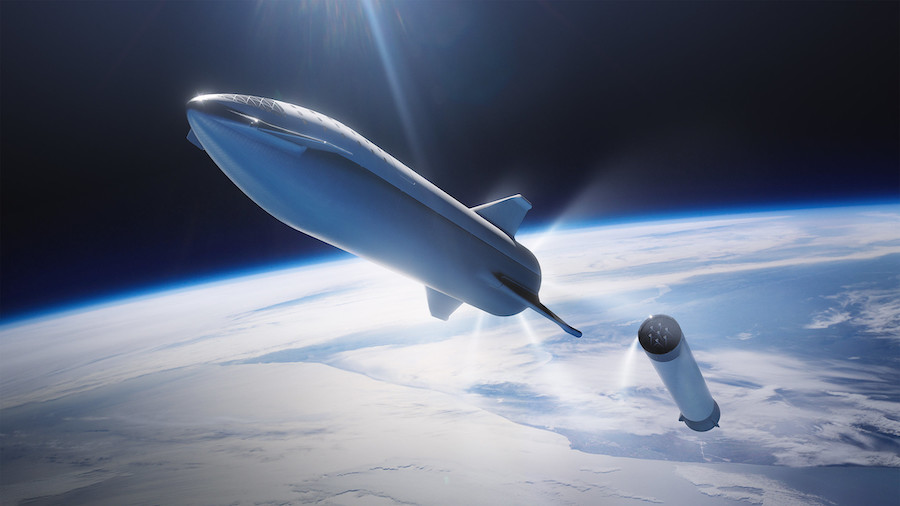SpaceX’s Starship prototype aces first untethered hop test – Spaceflight Now

An early test model of SpaceX’s Starship vehicle, which billionaire entrepreneur Elon Musk says will carry people and cargo to the moon and Mars, briefly left the ground in South Texas on its first untethered test flight Thursday night powered by the company’s new methane-fueled Raptor engine.
The silver test vehicle, made of stainless steel, took off around 10:45 p.m. CDT Thursday (11:45 p.m. EDT; 0345 GMT) at SpaceX’s launch and test facility in Boca Chica, Texas, a beachside community near Brownsville.
The Starship prototype, known as the Starship Hopper or “Starhopper,” was supposed to fly to a height of about 65 feet (20 meters), move sideways a bit, and then settle back on the ground on its three-legged landing gear.
The strange-looking cylindrical test vehicle, which lost its nose cone in a wind storm, measures about 30 feet (9 meters) wide. SpaceX teams opted to proceed with low-altitude hop tests without the nose cone, and observers have compared the vehicle’s appearance to that of a stubby water tower.
Elon Musk, SpaceX’s founder and CEO, declared the 22-second test flight a success.
“Starhopper flight successful,” Musk tweeted. “Water towers *can* fly haha!!”
Drone cam pic.twitter.com/gVdMrMgUZq
— e^👁🥧 (@elonmusk) July 26, 2019
SpaceX’s next-generation Raptor engine powered the Starhopper off the ground Thursday night. The throttleable engine is the biggest powerplant ever built by SpaceX, with more than twice the thrust of the Falcon 9 rocket’s Merlin engine.
The Raptor uses a technically complex full-flow staged combustion design intended to maximize performance and make the engine relatively easy to reuse.
Early versions the Raptor engine can produce up to 440,000 pounds of thrust at sea level, consuming super-cold methane and liquid oxygen propellants chilled to near their freezing points, a measure intended to increase efficiency, thrust and propellant density, allowing more fuel to be loaded into the launch vehicle.
Thursday night’s milestone leap came after a series of tests leading up to Starhopper’s first free flight.
In early April, an earlier model of the Raptor engine fired up for a pair of short tethered hops at the South Texas launch site. After installing a new Raptor engine on Starhopper, SpaceX teams fired up the vehicle earlier this month for a hold-down static fire test.
A fireball erupted around the Starhopper vehicle after engine shutdown, creating a dramatic scene but causing no damage.
“Big advantage of being made of high strength stainless steel: not bothered by a little heat!” Musk tweeted after the static fire test.
Musk tweeted a pair of videos from Thursday night’s test, one from an airborne drone hovering over the test site, and another from a camera fixed to the Starhopper vehicle itself, providing a detailed view of the Raptor engine.
Another Starhopper test flight, this time to an altitude of nearly 660 feet (200 meters), is planned in a week or two, Musk said.
SpaceX engineers working on competing teams at Boca Chica and in Cocoa, Florida, are building higher-fidelity versions of the Starship vehicle for higher-altitude, higher-speed test flights, which Musk projected could be ready for takeoff in two or three months.
Future Starship test flights from Florida are expected to take off from launch pad 39A at NASA’s Kennedy Space Center, a former Apollo and space shuttle launch pad now leased by SpaceX.
SpaceX is designing the Starship to fly in orbit, and eventually reach the moon, Mars, and other deep space destinations. The Starship is designed to land vertically on planetary surfaces using retro-propulsion, and then take off again, ferrying people and cargo between Earth and other locations in the solar system.

The U.S. government, so far, has little role in the Starship program.
NASA is focusing on the Space Launch System, Orion spacecraft and the development of a commercial lunar lander to achieve the Trump administration’s goal of landing astronauts the moon by 2024.
The U.S. Air Force, which needs powerful new rockets to carry satellites into orbit, has funded a fraction of the Raptor engine’s development costs. But the military did not select SpaceX last year as part of a round of rocket development contracts that went to SpaceX rivals United Launch Alliance, Blue Origin and Northrop Grumman.
The final Starship design, at least as currently understood, will use six Raptor engines for deep space missions. The new Starship prototypes under construction in Texas and Florida will each fly with at least three Raptors for suborbital jaunts.
SpaceX is aiming for the first orbital flight of the Starship vehicle in 2020.
For more ambitious voyages deeper into space, or carrying heavier cargo, the Starship will be coupled with a new booster design SpaceX calls the Super Heavy, with 35 Raptor engines clustered at its base.
In a recent interview with Time Magazine’s Jeffrey Kluger on “CBS Sunday Morning,” Musk claimed SpaceX could land on the moon with an unpiloted mission in just two years. A lunar landing mission with crew could be possible within a year or two after that, Musk said.
In his last formal update on the status of the Starship and Super Heavy program last September, Musk said the combined stack will stand some 387 feet (118 meters) tall, higher than NASA’s Apollo-era Saturn 5 moon rocket.
But Musk says SpaceX has made major changes to the ultimate design since last year, and he has hinted a more detailed update on the program’s progress will happen soon.
Email the author.
Follow Stephen Clark on Twitter: @StephenClark1.






